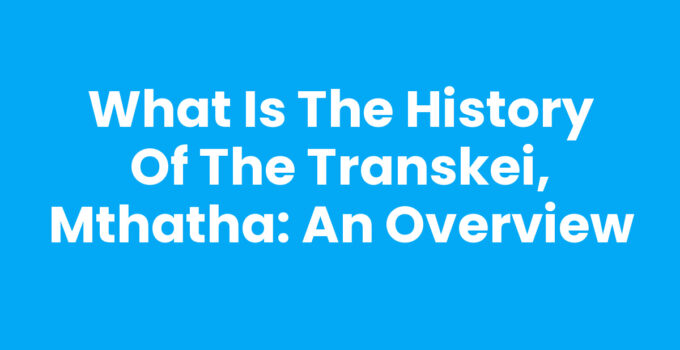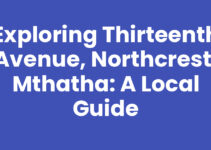Located in the Eastern Cape of South Africa, the Transkei region holds a rich tapestry of history, culture, and significance that reflects the diverse legacies of its people. Known for its stunning landscapes and vibrant communities, Transkei’s history is woven with tales of struggle, resilience, and the quest for identity. Mthatha, the capital of the former Transkei, is a focal point for understanding this intriguing past. This blog post will explore the intricate history of the Transkei, with a special focus on Mthatha.
What Is The History Of The Transkei, Mthatha: A Step-by-Step Exploration
The history of the Transkei region is complex, shaped by various socio-political dynamics and cultural influences over centuries. Let’s break it down into key phases:
1. Pre-Colonial Era
Before European colonization, the area that is now known as the Transkei was inhabited by the Xhosa people. The Xhosa nation, with its clans and sub-clans, had a defined social structure, rich traditions, and a strong connection to the land. These indigenous peoples engaged in agriculture, cattle herding, and trade among themselves and with neighboring groups.
2. Colonial Encounters
In the 18th and 19th centuries, European settlers, particularly the Dutch and British, began to encroach on the land inhabited by the Xhosa. The arrival of the British in the Eastern Cape led to a series of conflicts known as the Xhosa Wars, which significantly altered the political landscape. During this period, the British imposed their authority over the region, culminating in treaties that often favored colonial interests.
3. Formation of the Transkei
In 1963, the South African government officially established the Transkei as a bantustan (homeland) during the apartheid era, designating it for the Xhosa-speaking population. This action aimed to segregate various ethnic groups within South Africa, promoting a system that marginalized non-white populations. Mthatha emerged as the political center of the Transkei, housing the administrative and educational institutions for the bantustan.
4. Post-Apartheid Transition
Following the end of apartheid in 1994, the Transkei was reincorporated into South Africa. This new era brought about significant socio-economic changes and challenges. Although the political status of the Transkei changed, the legacy of apartheid still affects the region, requiring ongoing efforts to address inequality and development.
5. Contemporary Mthatha
Today, Mthatha is a vibrant city that serves as a cultural and administrative hub. It is known for its rich history, including sites such as the Nelson Mandela Museum, which pays tribute to the former president’s roots in the region. The city embodies a blend of tradition and modernity, attracting visitors who wish to explore both its historical landmarks and lively cultural scene.
Recommended Guide: What Is The Best Bank For A Student To Use In Mthatha
Significance of the Transkei and Mthatha in South African Culture
The Transkei region is not just significant for its historical context; it also plays an essential role in the cultural identity of the Xhosa people. The customs, traditional practices, and languages continue to thrive, showcasing resilience against the backdrop of historical challenges.
The Role of Land and Heritage
Land in the Transkei is deeply tied to cultural and spiritual practices, where ancestral lands play a crucial role in the identity of the Xhosa people. Craft activities, such as beadwork and traditional cloth-making, are prominent, combining art with historical narratives. Festivals and cultural ceremonies help preserve these traditions, drawing both locals and tourists to engage with this rich heritage.
Economic Development and Challenges
The economic landscape of Mthatha has dramatically changed, focusing on developing sectors such as tourism, agriculture, and small enterprise. However, challenges persist, including unemployment and infrastructure development. Community initiatives and government interventions are crucial to fostering sustainable growth and improving the quality of life for residents.
Related Guide: What Does “Mthatha” Mean In English? Discover Its Meaning
Conclusion
The history of the Transkei, with Mthatha as its heart, is a remarkable narrative of cultural heritage, struggle, and revival. Understanding this history is vital not only for appreciating the complexity of South Africa’s past but also for fostering a future that recognizes and respects the legacy of its diverse communities. As Mthatha continues to develop, it stands as a potent reminder of resilience and the ongoing journey toward reconciliation and progress.
Check This: How Do I Enroll My Child In A School In Mthatha: A Complete Guide
Frequently Asked Questions
What is the origin of the name Transkei?
The name Transkei means 'the land beyond the Kei River', referring to its geographical location in relation to the Kei River.
What are the main cultural aspects of Mthatha?
Mthatha is known for its Xhosa culture, traditional festivals, art, and heritage sites, including the Nelson Mandela Museum.
How did apartheid affect the Transkei region?
Apartheid led to the establishment of the Transkei as a bantustan, marginalizing its residents and influencing socio-economic conditions to this day.









